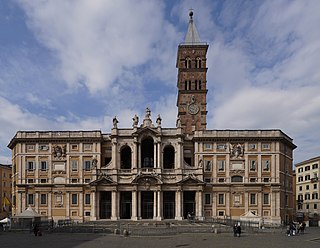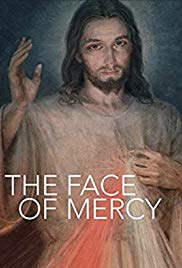A jubilee is a special year of remission of sins, debts and universal pardon. In Leviticus, a jubilee year is mentioned to occur every 50th year(7x7= Lev 25 v8-NRSV); during which slaves and prisoners would be freed, debts would be forgiven and the mercies of God would be particularly manifest.

The Basilica of Saint Mary Major, or church of Santa Maria Maggiore, is one of the four major papal basilicas as well as one of the Seven Pilgrim Churches of Rome and the largest Marian church in Rome, Italy. Santa Maria Maggiore is the first Marian sanctuary in the Western world and the mother of all sanctuaries.

Mercy is benevolence, forgiveness, and kindness in a variety of ethical, religious, social, and legal contexts.

A Holy Door is traditionally an entrance portal located within the Papal major basilicas in Rome. The doors are normally sealed by mortar and cement from the inside so that they cannot be opened. They are ceremonially opened during Jubilee years designated by the Pope, for pilgrims who enter through those doors to piously gain the plenary indulgences attached with the Jubilee year celebrations.

The Great Jubilee in 2000 was a major event in the Catholic Church, held from Christmas Eve 1999 to Epiphany 2001. Like other previous Jubilee years, it was a celebration of the mercy of God and forgiveness of sins. The major innovation in this Jubilee was the addition of many "particular Jubilees" for various groups of persons, and that it was simultaneously celebrated in Rome, Israel, and elsewhere in the world.

The Apostolic Penitentiary, formerly called the Supreme Tribunal of the Apostolic Penitentiary, is a dicastery led by the Major Penitentiary of the Roman Curia and is one of the three ordinary tribunals of the Apostolic See. The Apostolic Penitentiary is chiefly a tribunal of mercy, responsible for issues relating to the forgiveness of sins in the Catholic Church.

Urbi et Orbi denotes a papal address and apostolic blessing given by the pope on certain solemn occasions.

On 2 April 2005, at 21:37 UTC, Pope John Paul II died at the age of 84. His funeral was held on 8 April, followed by the novendiales devotional in which the Catholic Church observed nine days of mourning.
The history of the Catholic Church is integral to the history of Christianity as a whole. It is also, according to church historian Mark A. Noll, the "world's oldest continuously functioning international institution." This article covers a period of just under two thousand years.

Divine Mercy Sunday is a feast day that is observed in the Roman Rite calendar, as well as some Anglo-Catholics of the Church of England. It is celebrated on the Second Sunday of Easter, which concludes the Octave of Easter. It is originally based on the Catholic devotion to the Divine Mercy that Faustina Kowalska reported as part of her visions of Jesus, and is associated with special promises from Jesus and indulgences issued by the Catholic Church.

The Basilica della Santa Casa is a Marian shrine in Loreto, in the Marches, Italy. The basilica is known for enshrining the house in which the Blessed Virgin Mary is believed by some Catholics to have lived. Pious legends claim the same house was flown over by angelic beings from Nazareth to Tersatto, then to Recanati, before arriving at the current site.

The Immaculate Heart of Mary is a Catholic devotion which refers to the view of the interior life of Mary, her joys and sorrows, her virtues and hidden perfections, and, above all, her virginal love for God the Father, her maternal love for her son Jesus Christ, and her motherly and compassionate love for all mankind. Traditionally, the Immaculate Heart is depicted pierced with seven swords or wounds, in homage to the seven dolors of Mary and roses, usually red or white, wrapped around the heart.

As the home of the Pope and the Catholic curia, as well as the locus of many sites and relics of veneration related to apostles, saints and Christian martyrs, Rome had long been a destination for pilgrims. The Via Francigena was an ancient pilgrim route from England to Rome. It was customary to end the pilgrimage with a visit to the tombs of Saints Peter and Paul. Periodically, some were moved to travel to Rome for the spiritual benefits accrued during a Jubilee. These indulgences sometimes required a visit to a specific church or churches. Pilgrims need not visit each church.
Misericordia is the Latin word for "mercy", derived from misericors, "merciful", which is in turn derived from misereri, "to pity", and cor, "heart", and may refer to:

The Mariology of the popes is the theological study of the influence that the popes have had on the development, formulation and transformation of the Roman Catholic Church's doctrines and devotions relating to the Blessed Virgin Mary.

The Extraordinary Jubilee of Mercy was a Catholic period of prayer held from 8 December 2015, the Solemnity of the Immaculate Conception, to 20 November 2016, the Feast of Christ the King. Like previous jubilees, it was seen by the Church as a period for remission of sins and universal pardon focusing particularly on God's forgiveness and mercy. It was an extraordinary Jubilee because it had not been predetermined long before; ordinary jubilees are usually celebrated every 25 years.

Aperuit illis is an apostolic letter, by Pope Francis, issued "motu proprio" on September 30, 2019, the Feast of Saint Jerome, instituting the annual observance of the 3rd Sunday of Ordinary Time as "Sunday of the Word of God", devoted to the celebration, study and dissemination of the Word of God. The first "Sunday of the Word of God" occurred on January 26, 2020. The Pope said that he wrote the Apostolic Letter in response to requests from around the world to celebrate the Sunday of the Word of God.

The Sunday of the Word of God is an annual commemoration in the Catholic Church taking place on the third Sunday in Ordinary Time, during January. Pope Francis’ associated motu proprio, Aperuit illis, was published on 30 September 2019 and establishes that "the Third Sunday in Ordinary Time is to be devoted to the celebration, study and dissemination of the Word of God". The day first took place on 26 January 2020.

The Face of Mercy is a 2016 documentary about Faustina Kowalska, her mystical visions, and the role that the Divine Mercy has played in different people's lives. It is narrated by Jim Caviezel.
The 2025 Jubilee is a jubilee in the Catholic Church being celebrated in the year 2025. It was announced by Pope John Paul II at the end of the Great Jubilee. This jubilee was preceded by the Extraordinary Jubilee of Mercy of 2015–2016. The papal bull proclaiming the Jubilee is "Spes non confundit".





















